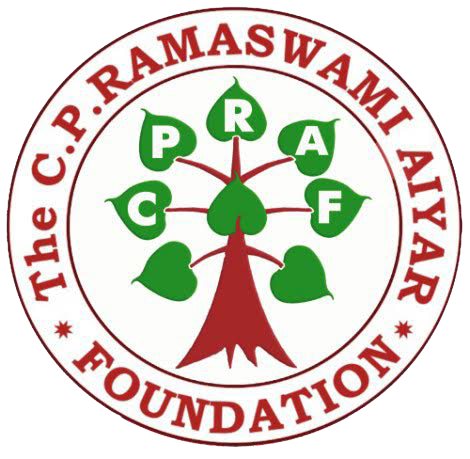


TRIBAL WELFARE
| TRAINING FOR KOTA, KURUMBA AND IRULA TRIBES |
|---|
Tribal life in the Nilgiris has been affected by external influences. Initially, it was the colonial western culture. Later in the post independence period, India’s developmental programmes have excluded tribal arts and crafts. In order to preserve the art forms of the tribals, the Foundation felt that it is necessary to ensure the continuity of their art. Hence the foundation has been training Kota, Kurumba and Irula youth to revive their traditional arts of pottery making, vegetable dye painting and bamboo craft. The Foundation has trained several Kota women in pottery and Kurumba youth in painting. Their creative endeavour has been channelized during the training to bring out a viable product, to fetch a commercial return.
Tribal art forms, especially those of the Kotas and Kurumbas, are nearly vanishing among the youngsters of the two tribes. Traditionally, the Kotas were potters and the Kurumbas the tribal shamans. Today, they have joined the hordes of cheap landless labour.
In order to preserve the arts and crafts of the Kotas and Kurumbas, it was necessary to ensure the continuity of their pottery of the former and the painting of the latter. The aim of this project was to train Kota and Kurumba youth in their disappearing traditional craft / art respectively, and adapt them for the contemporary market.
The C.P. Ramaswami Aiyar Foundation regularly organizes exhibitions and sales of their products in metropolitan cities like Chennai and Mumbai with due media coverage.
KOTA POTTERY
The Kota are traditional potters of the Nilgiri District. A scheduled Tribe, they are facing the possible extinction of their traditional practices. In the post independence period, India’s development programmes have excluded tribal arts and crafts. Today, the Kotas have joined the hordes of cheap landless labour. In order to preserve the arts and crafts of the Kotas, it is necessary to ensure the continuity of their tradition of making pottery. Hence they were trained to make small art pottery and terracotta. The aim of this project has been to preserve their craft tradition for posterity and to make it financially remunerative.
A set of tools to do the finishing activities like cutting, smoothening, wedging, sharpening, brushing, cleaning, carving, piercing, polishing, beading, etc, were provided, along with pounding rods, buckets, drum, sieve, cloth material to sieve, pans, mud slingers, pokers, plastic sheets, wire, strings, etc.
KURUMBA PAINTING
Kurumba drawing and painting is a unique tribal art form of the Nilgiris. This art is related to their rituals. This art could be seen only during festive occasions, although the Kurumbas once used to use these graphic motifs in their day-to-day living.
Eluthu paarai is an ancient 3000-year-old rock-painting site in the Kothagiri region of the Nilgiris. The Kurumbas – a tribe of hunters and medicine men – believe that the paintings are the work of their ancestors. Developments of the twentieth century have resulted in the Kurumbas losing their forests, thereby losing their traditional skills.
The paintings are primarily ritualistic, describing various facets of tribal life in the remote forests of the Nilgiris. They depict scenes like the Kurumba huts built of leaves and wood, women drying food grains, men collecting honey, weddings and rituals, earthen pens for hens and wild animals prowling the forest. The Kurumbas love the hills and have an exquisite style of painting. Originally, they drew with burnt twigs and coloured the paintings with a resin extracted from the bark of the Kino tree (Pterocarpus morsupium), leaves and different types of soil and stones were used for different colours. Most of their paintings are done by this method, which though cumbersome and time consuming, is appealing. However, today they also use water colours.



TIMELINE
2014-2015
2013-2014
2012-2013
2011-2012
2010-2011
2009-2010
2008-2009
2007-2008
2006-2007
2005-2006
2004-2005
2003-2004
2001-2002
2000-2001
1999 – 2000
| NATIONAL ENVIRONMENTAL AWARENESS CAMPAIGN (NEAC) |
|---|
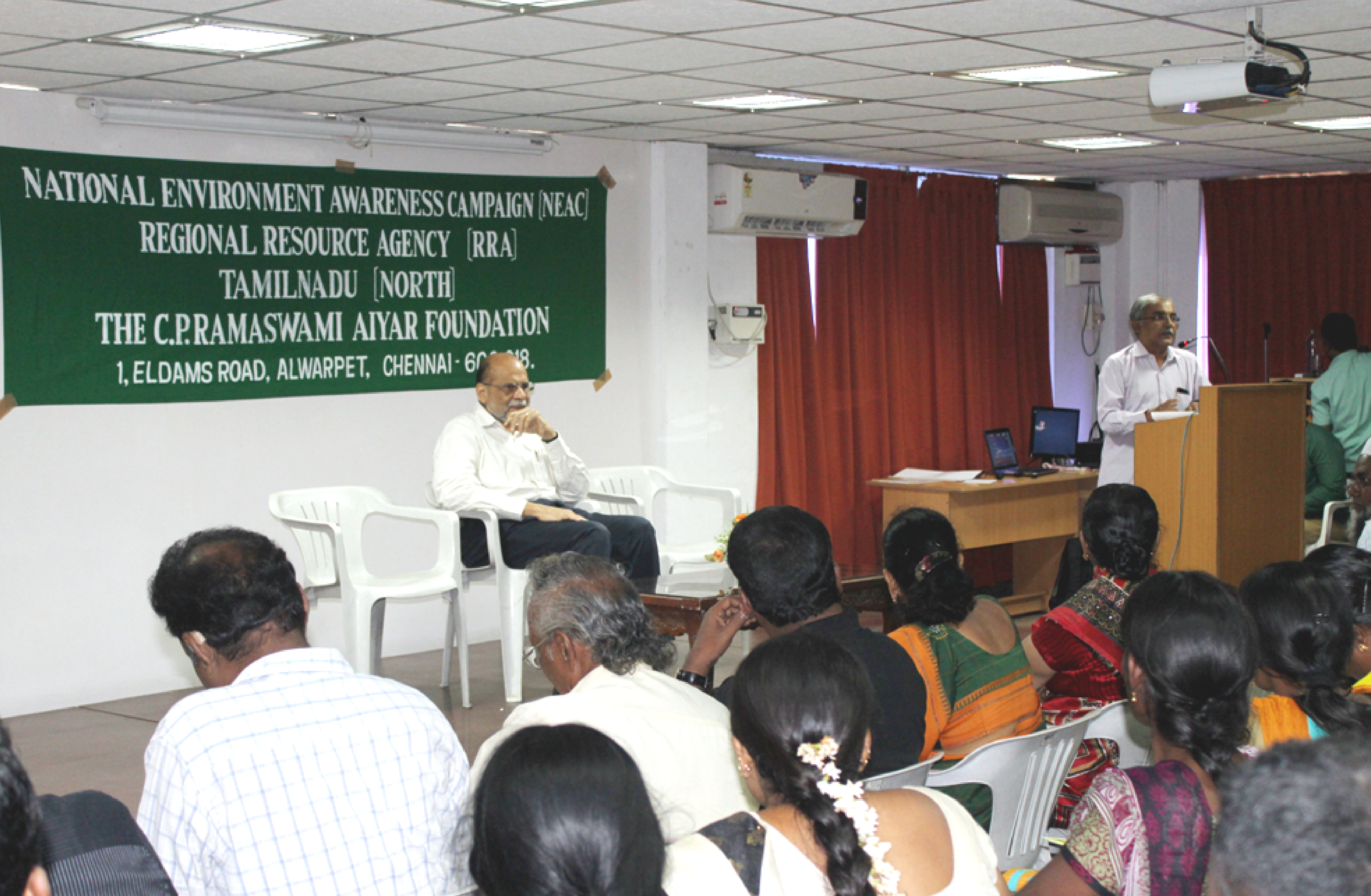
The National Environmental Awareness Campaign (NEAC) was launched by the Ministry of Environment and Forests, Government of India during the year 1985-86. NEAC is one of the major programmes of the Ministry of Environment and Forests to involve public participation in conservation and management of the environment.
The main motive of the programme is to create awareness among the public and make environmental protection a people’s movement, so that each and every citizen of this country should be involved in the protection of the environment. The local environmental problems must be highlighted during the programme to find a long and lasting solution for them.
To begin with only 150 NGOs participated throughout the country. Today more than 4000 NGOs, from all over the country participate in the NEAC programme. The theme for the NEAC is decided by the Ministry of Environment and Forests, Government of India every year.
The NEAC is a very vast and widespread outreach programme involving several sections of society and reaching down to the grass root level. This has been made possible because of the decentralized process. The Regional Resource Agencies (RRAs) know and work with many of the NGOs on environmental protection. The flexibility of the interaction between the RRAs and the participating organizations makes the programme creative and workable in spite of the vast numbers involved.
The NEAC has thrown up some very creative programmes and useful resource materials, both from the participating RRAs and NGOs. The NEAC has also been a means of understanding which process reaches the people in the most effective way. Thus performing arts are preferred to lectures, cycle rallies are better than seminars. What is common among the preferred processes is the low cost, entertainment value and easy accessibility and comprehensibility.
There is a definite perception of change: NGOs believe that deforestation has decreased in Western Orissa, environmental activism has grown in the Nilgiri Biosphere Reserve and tribal and rural communities have become powerful guardians of their natural resources. There are several environmental “success” stories attributed to the awareness generated by the NEAC.
The C.P. Ramaswami Aiyar Foundation (CPRAF), Chennai was chosen by the Ministry of Environment and Forests, Government of India in 1992-93 to function as the RRA for Tamilnadu and Pondicherry. The Foundation has been appointed as the RRA for the Andaman and Nicobar Islands also from the year 2000-2001. Over 300 NGOs are sanctioned under this scheme every year.
The details of the number of NGOs selected in Tamilnadu, Pondicherry and Andaman & Nicobar Islands are given below:
| Year | Number of Participating Agencies | Theme |
|---|---|---|
| 2014 – 2015 | 342 |
Combating Desertification, Land Degradation and Drought |
| 2013 – 2014 | 270 |
Bio-Diversity Conservation |
| 2012 – 2013 | 363 |
Bio-Diversity Conservation |
| 2011 – 2012 | 331 |
Forests for Sustainable Livelihood |
| 2010 – 2011 | 324 |
Bio-Diversity Conservation |
| 2009 – 2010 | 303 |
Climate Change |
| 2008 – 2009 | 243 |
Climate Change |
| 2007 – 2008 | 173 |
Bio-Diversity Conservation |
| 2006 – 2007 | 234 |
Solid Waste Management |
| 2005 – 2006 | 525 |
Solid Waste Management |
| 2004 – 2005 | 607 |
Solid Waste Management |
| 2003 – 2004 | 400 |
Water – The Elixir of life |
| 2002 – 2003 | 428 |
Water – The Elixir of life |
| 2001 – 2002 | 338 |
Sustainable Development |
| 2000 – 2001 | 289 |
Keep Our Environment Clean & Green |
| 1999 – 2000 | 228 |
Keep Our Environment Clean & Green |
| 1998 – 1999 | 204 |
Keep Our Water Resources Clean |
| 1997 – 1998 | 234 |
A. Pollution, Prevention & Control B. Conservation & Plantation Of Trees For Environmental Protection |
| 1996 – 1997 | 198 |
Medicinal Plants |
| 1995 – 1996 | 233 |
Women & Environment |
| 1994 – 1995 | 175 |
Joint Forest Management and Eco- Development for Youth & Women |
| 1993 – 1994 | 163 |
Animal Welfare and Waste Management |
| 1992 – 1993 | 142 |
Bio-Diversity |
| 1990 – 1991 | 61 |
Save the Environment Save Yourself |
| 1989 – 1990 | 59 |
Conserving our water resources |
| HEALTH AND NUTRITION |
|---|
TIBETAN MEDICAL CENTRE
It is popularly believed that the Tibetan Medical System is essentially a teaching of the Buddha himself as a way to liberate human beings from the vicious cycle of suffering. Later, with rich contributions from the medical traditions of neighbouring countries like India and China, and developed with the genius of its own people, Tibetan Medicine has emerged as one of the most sought after Alternative Medical Systems.
The medicines used are natural herbs that treat the root of the diseases without any unwelcome side effects. In addition to many common ailments, Tibetan medicine is best sought for its treatment of chronic diseases like asthma, rheumatic-arthritis, diabetes, hypertension, cardio-vascular diseases, nervous diseases, gynaecological problems, chronic cold and allergic problems, gastro-intestinal problems, various forms of cancer, psychosomatic disorders, etc.
Sensing the demand and popularity of Tibetan Medicine and being aware of its effectiveness, the C. P. Ramaswami Aiyar Foundation has established and sponsored the Tibetan Medical Centre in Chennai, at the C. P. Ramaswami Aiyar Foundation. The Centre was inaugurated in August 2010 at the Foundation premises by Dr. Dorjee Rapten, Chief Medical Officer of Men-tsee-Khang, Bangalore.
The Tibetan Medical Centre has started functioning permanently at the Foundation from 9 a.m. to 1 p.m. and 3 p.m. to 6 p.m., with a weekly holiday on Monday.
The people of Chennai have started treating this as a healing centre for many major chronic diseases like asthma, arthritis, diabetes mellitus, hypertension, cardio-vascular diseases, nervous diseases, gynaecological problems, chronic cold and allergic problems, gastro-intestinal problems, various forms of cancer, and psychosomatic disorders.
Dr. Dorjee Rapten Neshar, the Senior Doctor and Cancer Specialist in Bangalore, visits once a month for serious cases, especially of cancer, which has shown excellent response to Tibetan medicine.
NUTRITION
Although the Government of Tamilnadu gives a free nutritious midday meal to all children, it was felt that many came hungry in the mornings. It was therefore decided to give them a morning drink, P.S. High School for boys in Mylapore, Chennai, was chosen. The project was sponsored by Mr. Bala Venkataraman of Wooster, Ohio, USA, who was an alumnus of the school. The sattu maavu was provided through 2013-14.
In 2014-15, the project was continued by the C.P. Ramaswami Aiyar Foundation itself.
In 2015-16, Mr. Rajesh Mittal has come forward to provide the nutritious drink to the students of Lady Sivaswami Ayyar Girls Higher Secondary School, Chennai.
| TSUNAMI RELIEF & REHABILITATION |
|---|
WOOSTER NAGAR
Kanchipuram district, Tamilnadu
On December 26, 2004, a severe earthquake on the Indonesian coast in the Indian Ocean precipitated a series of massive waves known as tsunamis that devastated South Asia. The entire coastline of Tamilnadu was hit, particularly fishing villages which lost their homes, fishing boats, nets, household and personal items. Every village had several deaths, most of whom were children.
The C. P. Ramaswami Aiyar Foundation, along with the various institutions set up by it including C.P.R Environmental Education Centre, helped rehabilitate 22 villages from the Foundation's own funds and donations in kind given by several trusts and individuals. Relief materials including food, water, medicines and clothes were distributed.

Nobel Salai at Wooster Nagar
In Pudupattinam village, Kanchipuram District, the families of Angalaamman Kovil Street were badly affected. As a result, 26 families decided to move elsewhere. First it was the pace of relief they received; next it was the question of shelter. The villagers came together to secure a separate plot of land removed from their present location and 500 meters beyond the High tide line as required by the Coastal Regulation Zone (CRZ). When CPRAF contacted the then special tsunami Commissioner and Collector of Kanchipuram to suggest a village which was in compliance with the CRZ, this small community of 26 families was suggested. There after CPRAF contacted Wooster community, Ohio, through Mr. Bala Venkataraman, and Ms. Bina Venkataraman of Wooster was appointed as the co-coordinator of the project. A sum of about 40 lakhs was sent to CPRAF by Wayne County Community Foundation, Wooster. CPRAF decided to entrust the work to CPREEC. In order to form an environmentally sustainable village, the following works were taken up:
The keys to the houses were handed over to the families by US Consul General David T. Hopper on January 03, 2007.
CHILDREN'S PARK
Anumanthaikuppam, Villupuram district, Tamilnadu
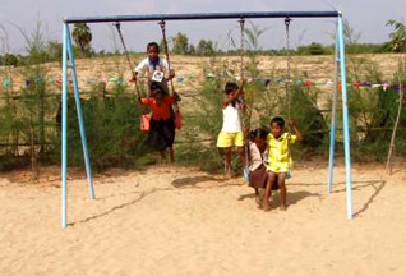
Tsunami Park at Anumanthaikuppam village
As a part of the effort to help the rehabilitation of tsunami affected areas, CPREEC also built a playground for children at Anumanthaikuppam village, Villupuram district. The area includes an amphitheatre. The park was inaugurated on December 26, 2006 – the second anniversary of the tsunami – by Ms. M. Bargavi Devendra, Hon. Secretary, Indian Red Cross Society, Tamilnadu.
The Foundation was approached by Women’s India Association (WIA), Chennai, for constructing a Creche and Balwadi for the children of the Tsunami affected families and the work has been completed.
300 books were purchased for the Library at the Community Centre which is used by the children and the public.
| REVIVAL OF FOLK ART FORMS IN SCHOOLS (1993 to 2005) |
|---|
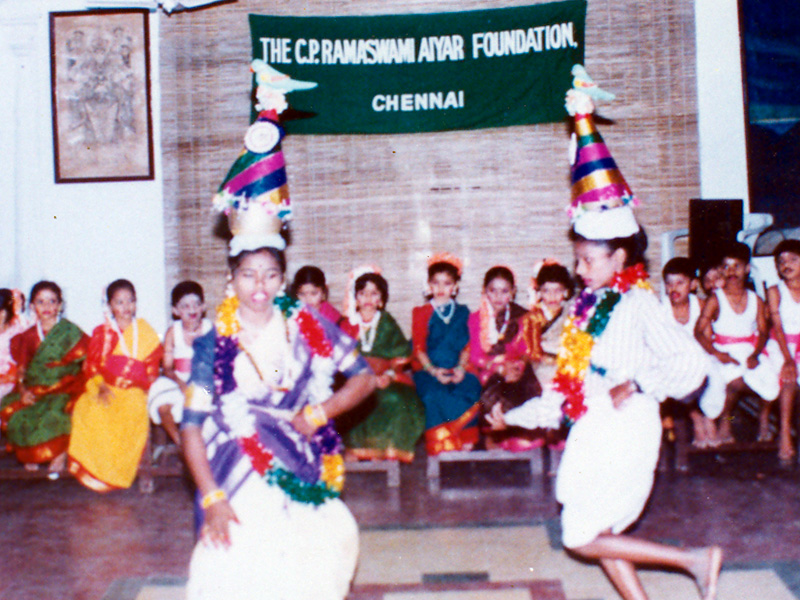
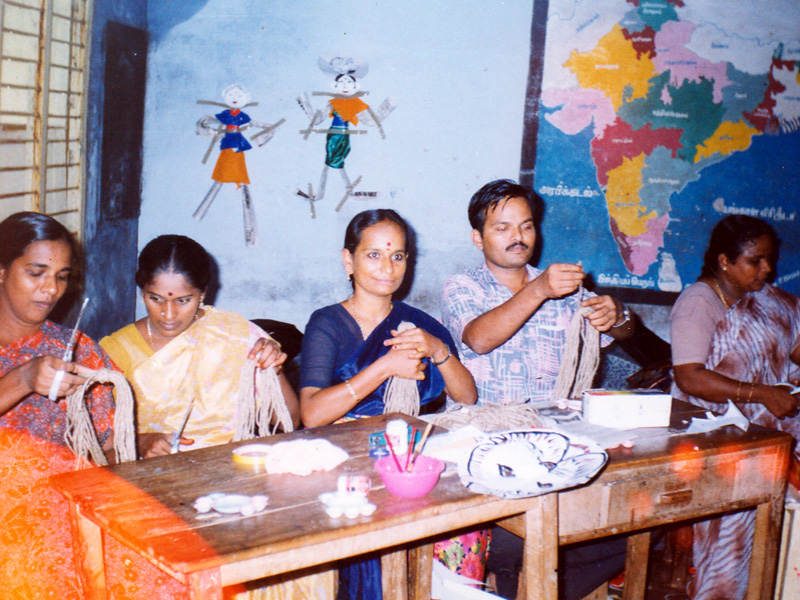
Tamil Nadu is the repository of several arts and crafts. Every village and its corresponding temple has been a nursery for the arts, which were passed down generations. These arts are devoid of rules and are highly flexible in character. Some are as old as the civilization itself, some belong to the recent past, some are even contemporary, and an instantaneous creation to a developing concern. With the onslaught of cinema, traditional folk art forms are slowly getting lost or pushed aside and this is apparent in both the performing and plastic arts.
Urbanization has severely affected the folk arts as the artists have migrated to nearby urban towns in search of jobs and the folk music and dance tradition of villages have almost come to an end. Also, our villages are now unfortunately paying the price for progress and development by allowing themselves to be transformed into satellite towns under the impact of that global phenomenon, the technological explosion.
The modern school curriculum also leaves only a little time for extra-curricular activities and as a result, children receive neither training nor exposure to the various arts and crafts. In Tamil Nadu, the importance attached to the cinema at one end and to classical music and dance at another has resulted in the gradual disengagement of folk culture from the lives of the people. In the process, folk culture is gradually being replaced by “Cinema culture”. It is imperative that Tamilnadu not only retains but also revitalizes the ethos of folk culture, a priceless heritage containing an enormous wealth of forms and traditions. Hence, the C.P. Ramaswami Aiyar Foundation took up a project on “Revival of Folk Art Forms in Schools”, sponsored by the Ministry of Human Resource Development, Government of India.
The project exposed children to the finer side of education and development through revival of folk culture. The project brought together folk artists (as resource persons) and teachers to convey important values, such as the oneness of people, the wonders of nature and the urgent problems of survival, conservation of natural resources, the importance of good health, hygiene, population control and national integration, through traditional art and culture.
The teachers were taught folk dances like kummi, kolattam, oyilattam, etc. set to the tune of traditional Tamil folk songs. The words of the songs expressed environmental concepts, health, nutrition and so on. The other subjects included puppetry and puppet making, using natural, inexpensive materials such as old newspaper, old greeting cards, used paper bags, rags, broomsticks, vegetables, etc. and traditional drawing and painting and traditional eco-friendly crafts.
As a follow-up, the project was evaluated by the Foundation later in the year, in the form of an inter-school district competition for the students, exhibitions of their arts and crafts and performances of their music and dance items, in all the areas in which the teachers attended the camps. The program also awoke the teachers’ creative potential. Apart from the teachers, the students, when given an opportunity to acquaint themselves with their cultural heritage, also had an outlet for their creativity, as youth is a vast storehouse of untapped potential.
The C. P. Ramaswami Aiyar Foundation had taken up projects on Revival of Folk Art Form in Schools in various districts of Tamil Nadu in from 1993 to 2005, sponsored by the Ministry of Human Resources Development. Every year, a few districts were chosen in Tamilnadu and in the Union Territory of Pondicherry. The Foundation covered a large number of schools in various districts of Tamil Nadu, viz. Chennai, Poonamalle, Tiruvallur, Kanchipuram, Chengalpattu, Tindivanam, Villupuram, Cuddalore, Thanjavur, Thiruvarur, and The Nilgiris.
With the excellent encouragement and coordination received from the State Education Department and the District Education Officials and taking into consideration the keen interest of teachers and students for the above project, the Foundation introduced “Intensive Refresher Courses” for a few districts every year, for teachers who already attended the camps on Revival of Folk Art Forms in Schools from some of the districts.
| CLEAN CHENNAI - GREEN CHENNAI |
|---|
The school curriculam does not have provision to imbibe the changing phenomena in the state of environment from year to year. The project aimed to create awareness among the students and teachers about pollution, the hazards and the remedial measures.
Aims and Objectives
The primary object of this project was to educate students about what is pollution, how to control it and the various health problems created by pollution and the agencies to which common man has a right for a clean environment. This project was carried out by conducting workshops for teachers and school students.
As the project title needed exhaustive coverage of Chennai, the entire city from Virugambakkam to Santhome, Avadi to Thiruvanmiyur, Anna Nagar to Tambaram, Triplicane to Royapuram - One or two schools from all these areas were participants in the teachers’ workshops.
Teaching Aids & Resource materials distributed are distributed to teachers and students during the workshops. Teachers and students of Chennai schools are taught the history of Chennai, its growth and pollution problems in this project which is sponsored by the Ministry of Human Resource Development, Government of India. Programmes for teachers, students and field activities are important components of this programme.
| TRAINING ADOLESCENT GIRLS IN TRADITIONAL DRAWING AND PAINTING TO ENHANCE THEIR EARNING CAPACITY |
|---|

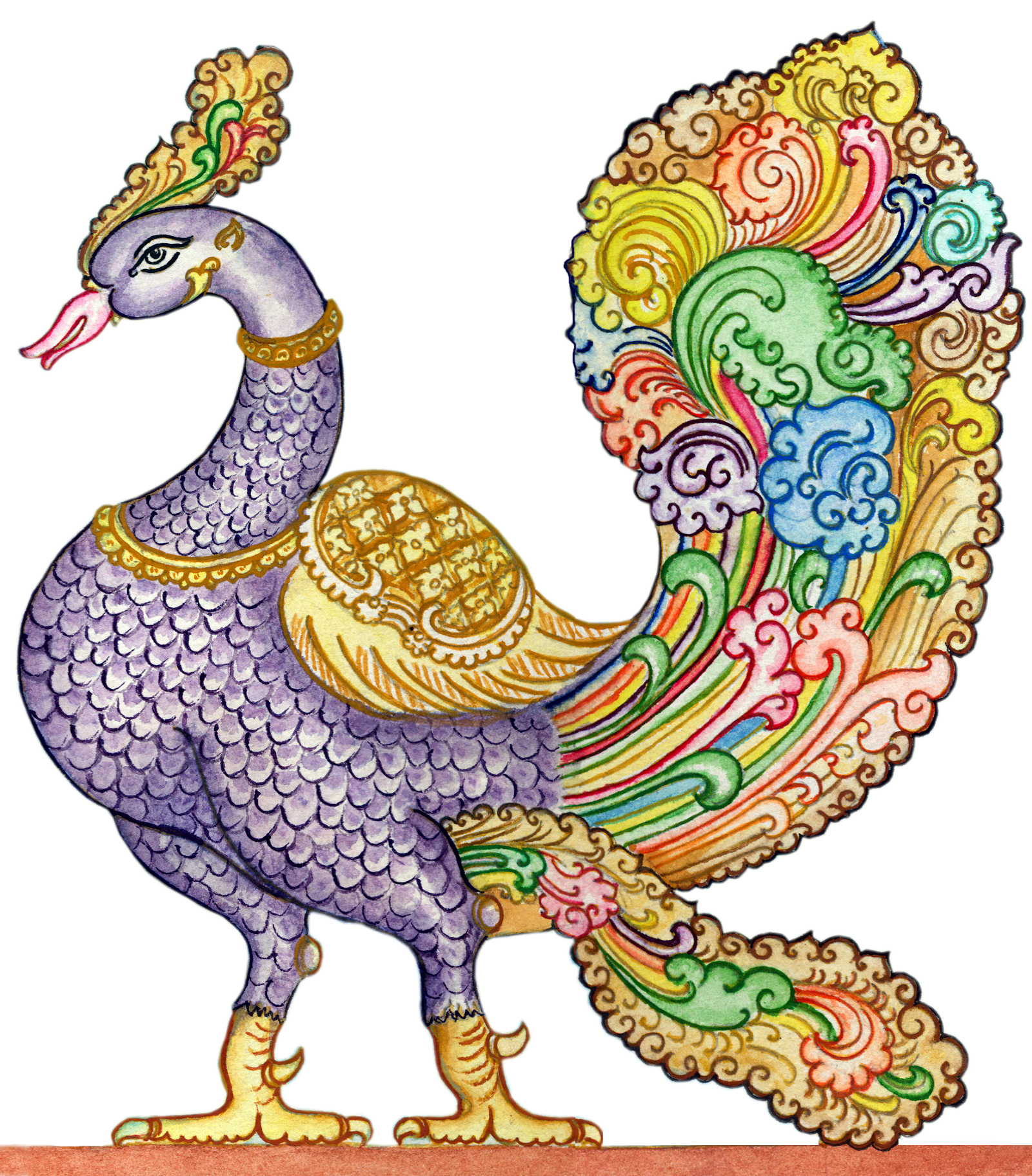

To find economic opportunities for the women of Mamallapuram, it was proposed to train 50 adolescent girls in traditional drawing and painting so that their employment opportunities will increase. They can make and sell paintings to the tourists visiting Mamallapuram. Or they may be employed as sculptors’ assistants.
As they lacked formal training, adolescent girls in the age group of 12 to 20 were chosen in and around Mamallapuram villages. Regular training in drawing and painting was imparted.
In 2003-2004, 50 girls were selected for basic training followed by another 50 girls in 2004-2005.